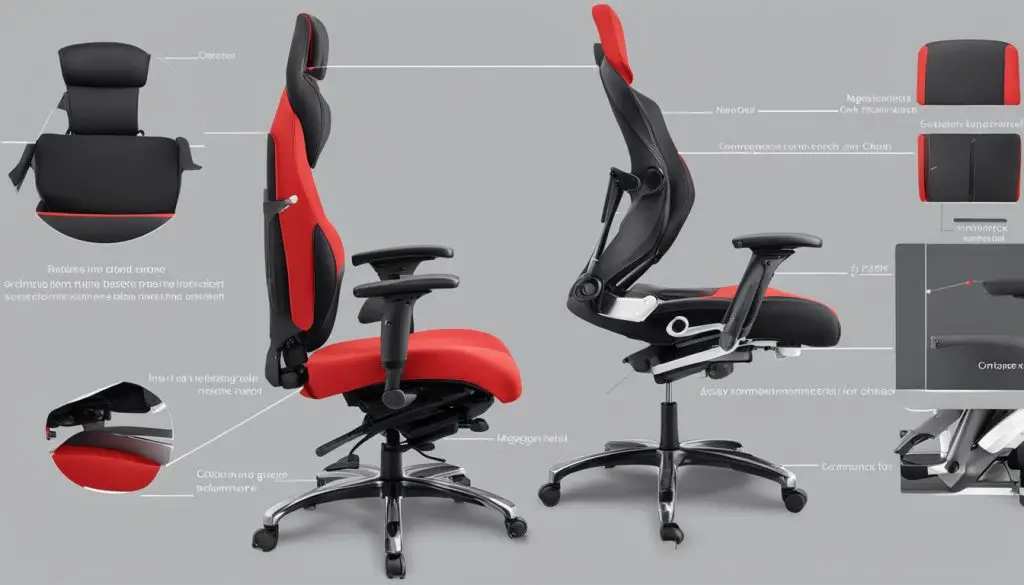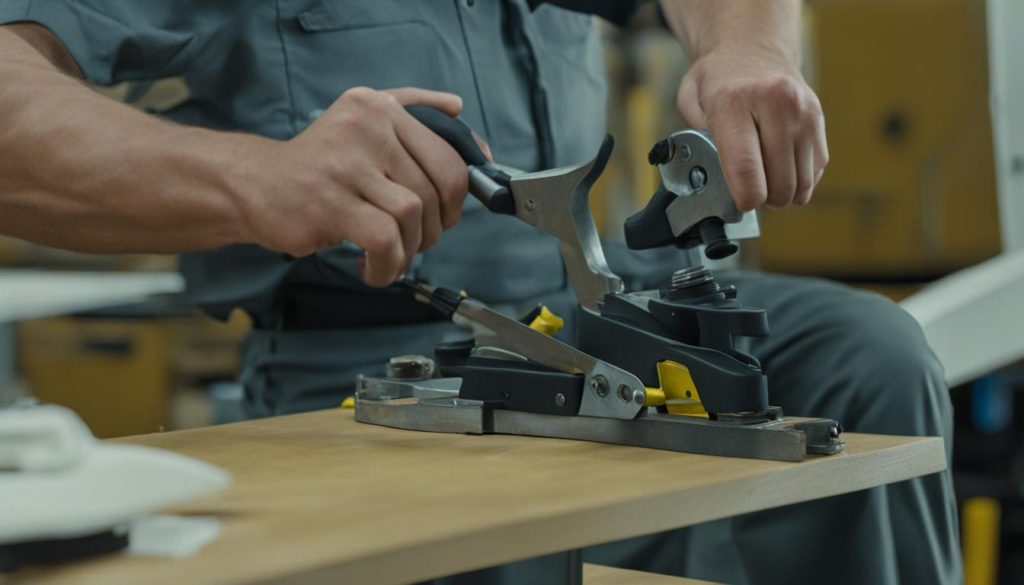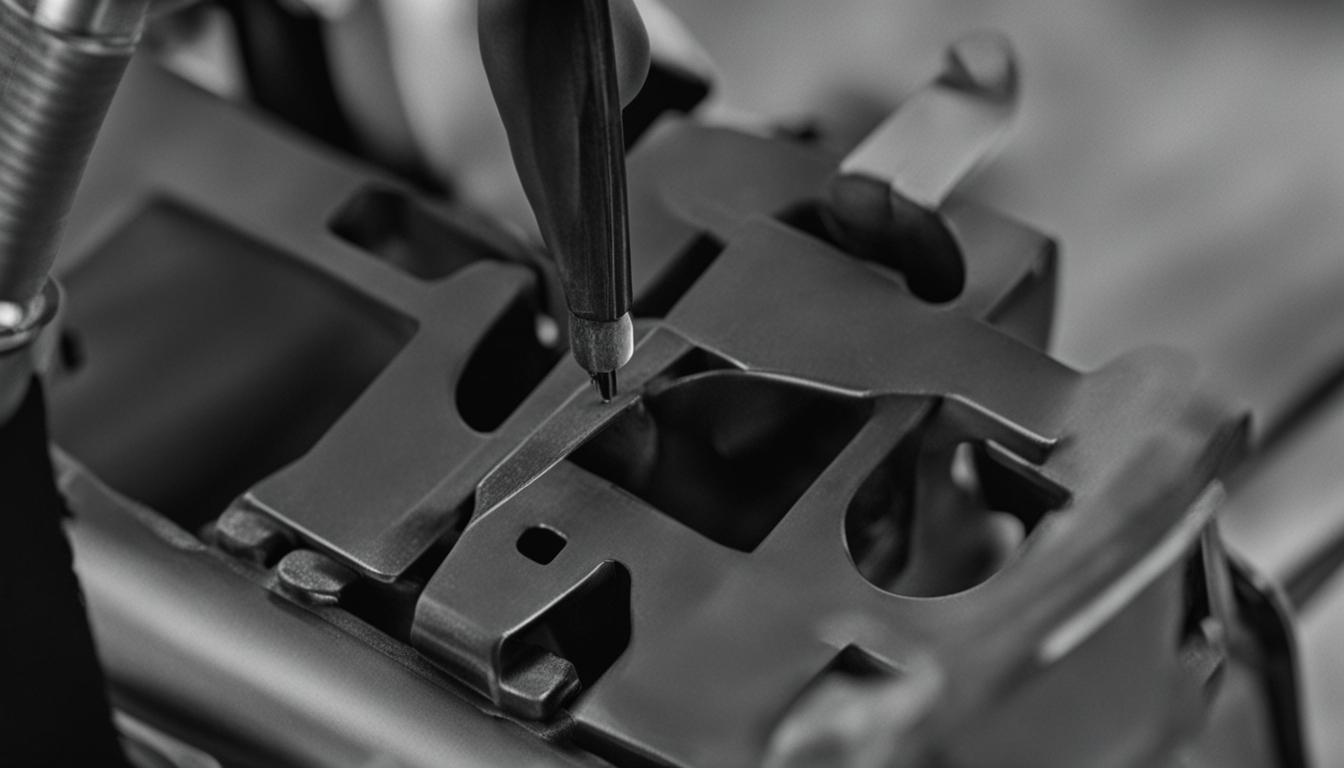Greetings! In this comprehensive guide, I will walk you through the step-by-step process of disassembling an office chair. Whether you need to perform maintenance, transport the chair, or simply satisfy your curiosity, this guide will equip you with the necessary knowledge to successfully disassemble your office chair.
Key Takeaways:
- A flathead screwdriver, Phillips-head screwdriver, pliers, and a soft cloth or towel are essential tools for office chair disassembly.
- Start by removing the seat and backrest cushions, followed by the chair’s base.
- Disassemble the gas lift cylinder, armrests, and backrest in the subsequent steps.
- Pack and transport the disassembled chair components securely.
- Maintain your office chair regularly for optimal performance and comfort.
Tools Required for Disassembling an Office Chair
When it comes to disassembling an office chair, having the right tools is essential. Here are the tools you’ll need to successfully dismantle your chair:
- Flathead screwdriver: This tool is perfect for unscrewing or prying open components of the chair.
- Phillips-head screwdriver: This type of screwdriver is essential for removing screws with cross-shaped slots.
- Pliers: Pliers are handy for gripping and twisting stubborn bolts or screws.
- Soft cloth or towel: Use this to protect delicate parts of the chair from scratches or damage while disassembling.
With these tools at your disposal, you’ll be well-equipped to take apart your office chair with ease.
Removing the Seat and Backrest Cushions
When it comes to disassembling a task chair, the first step is removing the seat and backrest cushions. This crucial step allows access to other components and eases the overall disassembly process. To begin, locate the screws that attach the cushions to the chair frame. You may need to flip the chair over or inspect underneath the cushions to find them.
Once you have located the screws, use the appropriate screwdriver to carefully remove them. It’s important to take your time and ensure that all screws are fully loosened before attempting to lift the cushions away from the frame. Depending on the chair model, there may be multiple screws to remove.
Once the screws are removed, gently lift the cushions away from the chair frame. Take care not to force or tug at the cushions, as this can cause damage to the fabric or upholstery. If the cushions are still firmly attached, double-check for any additional screws or fasteners that may be securing them in place.
Table: Steps to Remove Seat and Backrest Cushions
| Step | Action |
|---|---|
| 1 | Flip the chair over or inspect underneath the cushions to locate the screws. |
| 2 | Use the appropriate screwdriver to carefully remove the screws. |
| 3 | Gently lift the cushions away from the chair frame, taking care not to damage the fabric or upholstery. |
| 4 | Check for any additional screws or fasteners that may be securing the cushions in place. |
“Removing the seat and backrest cushions is an essential step in disassembling an office chair. By carefully following the process and taking your time, you can easily access other components and continue the disassembly process smoothly.”
Removing the Chair’s Base
In order to completely disassemble an office chair, the next step after removing the cushions is to remove the chair’s base. This is necessary for maintenance, repair, or transportation purposes. The process of removing the base is relatively straightforward, but it requires caution and the use of appropriate tools.
To begin, turn the chair upside down on a soft cloth or towel to protect the surface. This will provide stability and prevent any scratches or damage while working on the chair. Once the chair is secured, locate the screws or bolts that secure the base to the seat plate. These may be located on the bottom of the seat plate or around the perimeter of the base.
Using the appropriate tool, such as a screwdriver or wrench, carefully remove the screws or bolts. It is important to note that there may be multiple screws or bolts securing the base. Once all screws or bolts are removed, gently pull the base away from the seat plate. Take care not to force or pry the base, as this may cause damage to the chair or its components.
By following these steps, you will be able to safely and effectively remove the chair’s base. This will allow you to access and disassemble other components of the chair, such as the gas lift cylinder, armrests, and backrest. Remember to keep track of the screws, bolts, and other small parts during the disassembly process to ensure smooth reassembly and avoid any potential issues.
Table: Tools for Removing the Chair’s Base
| Tool | Description |
|---|---|
| Flathead screwdriver | Used to remove screws or pry components |
| Phillips-head screwdriver | Used to remove screws with Phillips-head slots |
| Wrench | Used to loosen and tighten bolts |
| Soft cloth or towel | Used to protect the chair’s surface while working |
Disassembling the Gas Lift Cylinder
Now that the base of the office chair is removed, it’s time to disassemble the gas lift cylinder. This component is responsible for adjusting the height of the chair, and it’s essential to remove it properly to ensure a successful disassembly process.
To begin, locate the retaining clip at the bottom of the gas lift cylinder. This clip holds the cylinder in place and needs to be pried off using a flathead screwdriver. Gently insert the screwdriver under the clip and apply slight pressure to release it from the cylinder.
Once the retaining clip is removed, you can start detaching the gas lift cylinder from the base. Hold the base firmly and pull the cylinder away from it. If the cylinder is still attached to the seat plate, you can use a rubber mallet to tap it gently and help release it.
Remember to handle the gas lift cylinder with care as it contains compressed air or gas. Avoid applying excessive force during the disassembly process to prevent any accidents or damage to the component. With the gas lift cylinder successfully removed, you can proceed to disassemble the remaining parts of the office chair.
Summary:
- Locate and remove the retaining clip at the bottom of the gas lift cylinder using a flathead screwdriver.
- Detach the gas lift cylinder from the base by pulling it away carefully or tapping it gently with a rubber mallet if still attached to the seat plate.
- Handle the gas lift cylinder with caution to avoid accidents or damage.
- Proceed to disassemble the remaining parts of the office chair.
Table: Gas Lift Cylinder Disassembly Steps
| Step | Description |
|---|---|
| 1 | Locate the retaining clip at the bottom of the gas lift cylinder. |
| 2 | Using a flathead screwdriver, pry off the retaining clip. |
| 3 | Hold the base firmly and pull the gas lift cylinder away from it. |
| 4 | If the cylinder is still attached to the seat plate, gently tap it with a rubber mallet to release it. |
Disassembling the Armrests and Backrest
With the base and gas lift cylinder removed, it’s time to disassemble the armrests and backrest of your office chair. This step-by-step guide will walk you through the process of removing these components to ensure a successful disassembly.
Disassembling the Armrests
To begin, locate the screws or bolts that secure the armrests to the seat plate. Use the appropriate tool, such as a screwdriver or wrench, to loosen and remove these fasteners. Take note of the number and placement of the screws as you will need this information when reassembling the chair.
Once the screws or bolts are removed, gently pull the armrests away from the seat plate. Be cautious not to force them as this may cause damage to the chair. Set the armrests aside in a safe location until you are ready to reassemble the chair.
Disassembling the Backrest
Similar to the armrests, the backrest is also attached to the seat plate with screws or bolts. Locate these fasteners and use the appropriate tool to loosen and remove them. Ensure that you keep track of the number and placement of the screws for later reassembly.
Once the screws or bolts are removed, gently separate the backrest from the seat plate. Take care not to strain any connectors or cables that may be present. Set the backrest aside along with the armrests, keeping them in a secure place until you are ready to reassemble the chair.

Now that you have successfully disassembled the armrests and backrest, you can proceed to the next steps in the office chair disassembly process. By following this guide, you’ll be able to dismantle your chair with confidence and ensure a smooth reassembly process.
Packing and Transporting the Disassembled Office Chair
Once your office chair is disassembled, it’s important to properly pack and transport the individual components. This ensures that the chair remains protected during transit and can be easily reassembled at its destination. Here are some guidelines to follow:
Gathering the Necessary Supplies
Before packing the disassembled chair, gather the necessary supplies: bubble wrap or packing paper, a sturdy box or container, and tape. The bubble wrap or packing paper will provide cushioning and protection for the chair components, preventing any scratches or damage. Make sure the chosen box or container is large enough to hold all the pieces securely, and use tape to seal it.
Wrapping and Securing the Components
Start by wrapping each individual component in bubble wrap or packing paper. This includes the seat and backrest cushions, base, gas lift cylinder, armrests, and backrest. Ensure that each component is fully covered and protected. For added security, you can also use tape to secure the wrapping in place. This will prevent the components from shifting or getting damaged during transportation.
Labeling and Organizing
To make reassembly easier, it’s important to label and organize the various screws, bolts, and small parts that were removed during disassembly. Place these items in a labeled plastic bag and securely tape it to one of the chair’s components. This way, all the necessary hardware will be easily accessible when it’s time to reassemble the chair.
| Component | Hardware |
|---|---|
| Seat and backrest cushions | Screws (4) |
| Base | Bolts (4) |
| Gas lift cylinder | Retaining clip |
| Armrests | Screws (2) |
| Backrest | Screws (4) |
By organizing and labeling the hardware, you’ll save time and frustration when it comes to reassembling the chair.
With the components wrapped, secured, and properly labeled, your disassembled office chair is now ready for transportation. Ensure that the packed chair is handled with care during transit to avoid any accidental damage. Once you’ve arrived at your destination, refer to the step-by-step guide in the previous sections to reassemble your chair.
Routine Maintenance for Office Chairs
Proper maintenance is essential to keep your office chair in good condition and ensure its longevity. By regularly cleaning and inspecting your chair, as well as performing some routine care, you can extend its lifespan and have a comfortable seating experience. Here are some important maintenance steps to follow:
- Clean the chair components: Use a soft cloth or sponge and a mild cleaning solution to wipe down the seat, backrest, armrests, and any other upholstered areas of the chair. This will help remove dust, dirt, and stains. Avoid using harsh chemicals or abrasive cleaners as they may damage the fabric or surface of the chair.
- Inspect for damage: Regularly check your office chair for any signs of wear or damage. Look for loose screws or bolts, tears in the upholstery, or worn-out padding. If you notice any issues, address them promptly to prevent further damage and ensure the chair remains safe and functional.
- Lubricate moving parts: If your office chair has adjustable features like a tilt mechanism or height adjustment, it’s important to keep these moving parts lubricated. Apply a small amount of silicone-based lubricant to the mechanisms to ensure smooth and effortless operation. This will prevent them from becoming stiff or squeaky over time.
- Tighten screws and bolts: As part of your routine maintenance, check all the screws and bolts on your office chair and tighten them if necessary. Over time, these fasteners may loosen due to regular use. Keeping them properly tightened will help maintain the stability and structural integrity of the chair.
By following these maintenance guidelines, you can keep your office chair in excellent condition and enjoy many years of comfortable and productive use. Remember, a well-maintained chair not only provides ergonomic support but also enhances the overall aesthetics of your workspace.
Reassembling the Office Chair
Now that you have successfully disassembled your office chair for maintenance or transportation, it’s time to put it back together. Reassembling the chair may seem intimidating, but by following a few simple steps, you can have your chair restored to its original state in no time.
Step 1: Organize Your Components
Before you begin reassembling your office chair, take a moment to organize all the components you have disassembled. Lay them out in a clear and logical order, making it easy for you to locate each piece when needed. This will save you time and frustration during the reassembly process.
Step 2: Follow the Disassembly Steps in Reverse Order
The best way to reassemble your office chair is to follow the same steps you used during the disassembly process, but in reverse order. Start with the armrests and backrest, attaching them securely to the seat plate using the appropriate screws or bolts. Then, reattach the gas lift cylinder to the base, making sure it is properly inserted and secure. Finally, reattach the seat and backrest cushions to the chair frame, using the screws you previously removed.
Throughout the reassembly process, make sure to align all the components correctly and tighten all screws and bolts securely. This will ensure that your office chair is stable and safe for use.
Step 3: Perform a Final Inspection
Once you have reassembled your office chair, it’s important to perform a final inspection to ensure everything is in place and functioning properly. Take a few moments to check all screws and bolts, making sure they are tightened adequately. Test the chair’s stability and adjustability, ensuring that it operates smoothly without any wobbling or squeaking.
By carefully following these reassembly steps, you can have your office chair back together and ready for use. Remember, if you encounter any difficulties or are unsure about any steps, consult the manufacturer’s manual or seek professional assistance.
“Reassembling an office chair may seem daunting, but by following a few simple steps, you can have your chair restored to its original state in no time.”
When to Seek Professional Assistance
If you find the process of disassembling an office chair to be challenging or don’t have the time to do it yourself, it’s worth considering hiring a professional office chair disassembly service. These experts specialize in dismantling office chairs, ensuring a hassle-free experience and saving you valuable time and effort.
Professional office chair disassembly services have the knowledge and expertise to handle all types of office chairs, from task chairs to ergonomic chairs. They are equipped with the necessary tools, skills, and experience to disassemble the chair efficiently and safely, without causing any damage to the components.
By opting for a professional service, you can have peace of mind knowing that your office chair will be disassembled properly and with care. This is particularly important if you plan to transport the chair or if you want to ensure that it can be reassembled correctly after maintenance or repairs. Additionally, professional services often offer packing and transportation services, further simplifying the process for you.
If you’re unsure about disassembling an office chair yourself or simply prefer to leave it in the hands of professionals, hiring a professional office chair disassembly service is a convenient and reliable solution. They will handle the entire disassembly process for you, allowing you to focus on other tasks and ensuring that your chair is ready for maintenance, transportation, or any other purpose you may have.

| Pros | Cons |
|---|---|
| Save time and effort | Additional cost |
| No risk of damaging the chair | Lack of control over the process |
| Expertise and experience | Reliance on external service |
| Convenience and peace of mind |
Conclusion
Disassembling an office chair may seem like a daunting task, but with a step-by-step guide, it can be accomplished successfully. By following the provided instructions, you can easily disassemble your office chair for maintenance, transportation, or other purposes.
Remember to gather the necessary tools, such as a flathead screwdriver, Phillips-head screwdriver, pliers, and a soft cloth. These tools will be essential in removing screws, bolts, and other fasteners.
Take your time and exercise caution throughout the process to avoid damaging any components. Start by removing the seat and backrest cushions, followed by the chair’s base, gas lift cylinder, armrests, and backrest. Finally, pack and transport the disassembled chair by wrapping each component in protective material and securely labeling and storing the screws and bolts.
Whether you’re disassembling your office chair for maintenance or relocating, following the step-by-step guide will ensure a smooth experience. Remember, if you don’t have the time or expertise to disassemble the chair yourself, consider hiring a professional office chair disassembly service to handle the process for you.
FAQ
What tools do I need to disassemble an office chair?
You will need a flathead screwdriver, Phillips-head screwdriver, pliers, and a soft cloth or towel for protection.
How do I remove the seat and backrest cushions?
Locate the screws that attach the cushions to the chair frame and use the appropriate screwdriver to remove them. Carefully lift the cushions away from the frame.
How do I remove the chair’s base?
Turn the chair upside down on a soft cloth or towel to protect the surface. Locate the screws or bolts that secure the base to the seat plate and use the appropriate tool to remove them. Gently pull the base away from the seat plate.
How do I disassemble the gas lift cylinder?
Pry off the retaining clip from the bottom of the cylinder using a flathead screwdriver and pull the cylinder away from the base. If the cylinder is still attached to the seat plate, gently tap it with a rubber mallet to release it.
How do I disassemble the armrests and backrest?
Locate the screws or bolts that secure the armrests to the seat plate and use the appropriate tool to remove them. Gently pull the armrests away from the seat plate. Repeat the process for the backrest.
How should I pack and transport the disassembled office chair?
Wrap each component in bubble wrap or packing paper for protection. Use a sturdy box or container to hold all the pieces and securely tape a labeled plastic bag containing screws, bolts, and small parts to the chair’s components.
What maintenance steps should I perform before reassembling my office chair?
Clean the chair components using a soft cloth and mild cleaning solution, inspect for damage, lubricate moving parts, and tighten screws and bolts.
How do I reassemble the office chair?
Follow the disassembly steps in reverse order, aligning all components correctly and securely tightening all screws and bolts.
When should I consider hiring a professional office chair disassembly service?
If you don’t have the time or expertise to disassemble your chair yourself, it’s worth considering hiring a professional service to handle the disassembly process.
Is disassembling an office chair difficult?
With the right tools and step-by-step instructions, disassembling an office chair can be done successfully. Take your time, exercise caution, and avoid damaging any components.


